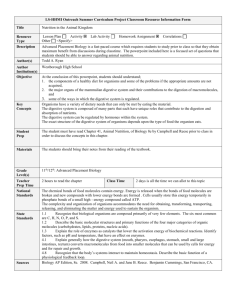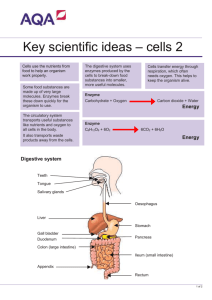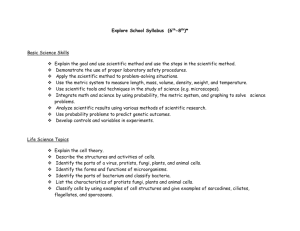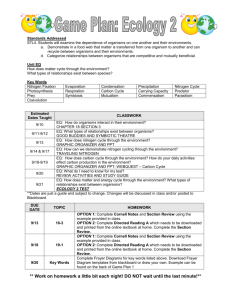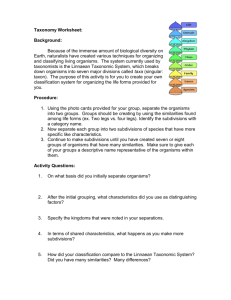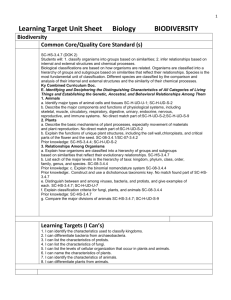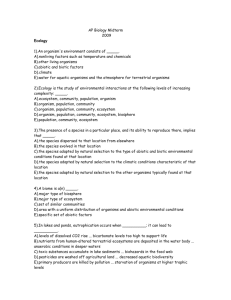AP Midterm Review Ecology *Vocabulary words to know: biome
advertisement
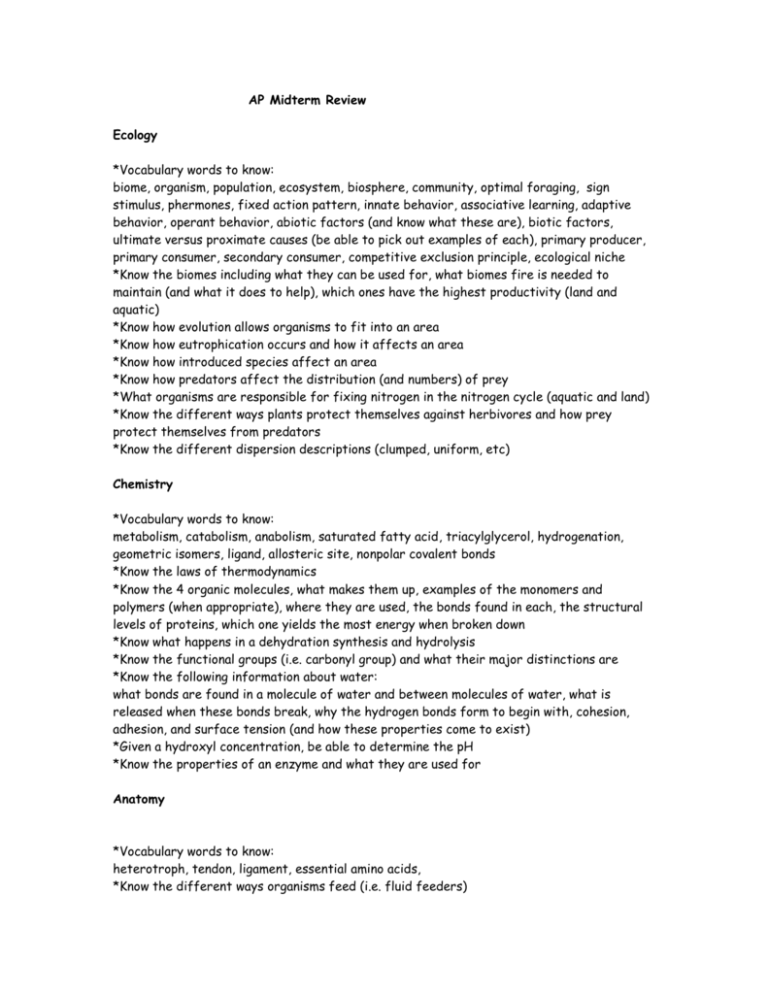
AP Midterm Review Ecology *Vocabulary words to know: biome, organism, population, ecosystem, biosphere, community, optimal foraging, sign stimulus, phermones, fixed action pattern, innate behavior, associative learning, adaptive behavior, operant behavior, abiotic factors (and know what these are), biotic factors, ultimate versus proximate causes (be able to pick out examples of each), primary producer, primary consumer, secondary consumer, competitive exclusion principle, ecological niche *Know the biomes including what they can be used for, what biomes fire is needed to maintain (and what it does to help), which ones have the highest productivity (land and aquatic) *Know how evolution allows organisms to fit into an area *Know how eutrophication occurs and how it affects an area *Know how introduced species affect an area *Know how predators affect the distribution (and numbers) of prey *What organisms are responsible for fixing nitrogen in the nitrogen cycle (aquatic and land) *Know the different ways plants protect themselves against herbivores and how prey protect themselves from predators *Know the different dispersion descriptions (clumped, uniform, etc) Chemistry *Vocabulary words to know: metabolism, catabolism, anabolism, saturated fatty acid, triacylglycerol, hydrogenation, geometric isomers, ligand, allosteric site, nonpolar covalent bonds *Know the laws of thermodynamics *Know the 4 organic molecules, what makes them up, examples of the monomers and polymers (when appropriate), where they are used, the bonds found in each, the structural levels of proteins, which one yields the most energy when broken down *Know what happens in a dehydration synthesis and hydrolysis *Know the functional groups (i.e. carbonyl group) and what their major distinctions are *Know the following information about water: what bonds are found in a molecule of water and between molecules of water, what is released when these bonds break, why the hydrogen bonds form to begin with, cohesion, adhesion, and surface tension (and how these properties come to exist) *Given a hydroxyl concentration, be able to determine the pH *Know the properties of an enzyme and what they are used for Anatomy *Vocabulary words to know: heterotroph, tendon, ligament, essential amino acids, *Know the different ways organisms feed (i.e. fluid feeders) *Know the steps of digestion and which ones require enzymes *Know the major secretions of the digestive organs and where they are secreted *Know the different fat-soluble vitamins and why eating excessive amounts of these vitamins is dangerous *Know which storages in the body are used first in the absence of food and which are reserved until absolutely needed and what would occur on a long-term low-fat diet (hint: think about what the purpose of fat is energy wise!!) *Know the four major tissue types (i.e. connective) and examples of each – for cartilage, make sure you know the fiber types and where they are found and for epithelial, make sure you know where it is found *Know what fibroblasts secrete *Know why herbivorous digestive tracts are longer than carnivorous *Know the increasing level of complexity (starting with cells, ending with organism) *Know what occurs when blood sugar levels rise Classification *Know the importance of the amniotic egg *Know the feeding mechanism of sponges *Know what phylum jellyfish and corals belong to *Know the function of the mycelium in fungi and what the cell walls of fungi are composed of *Know the difference between the digestive systems of sponges, flatworms, annelids, roundworms, and sea anemones *Know what saprobic fungi do Know why fungi are technically considered heterotrophs Essays You must bring in typed essays for the test on the following topics: 1). Feedback mechanisms are used by organisms to maintain the steady-state physiological condition known as homeostasis. For both of the following, explain how feedback mechanisms maintain homeostasis. a) Blood glucose concentration. c) Body temperatures in mammals. 2). Discuss the lock-and-key theory of enzyme-substrate interaction giving a specific example to illustrate the theory. Include in your discussion the effects of each of the following: a. Substrate concentration b. pH shifts c. Temperature shifts d. Competititve inhibition 3). Describe the biogeochemical cycles of carbon and nitrogen. Trace these elements from the point of their release from a decaying animal to their incorporation into a living animal. In-class On exam day, you will be asked the following: *Given results from an experiment, you will need to design the experiment that could have led to these results. The experiment will be on enzyme activity changes with pH and temperature. You will be asked to also discuss the structure and function of the enzyme and how they are affected by a change in either one of these variables. *In addition, you will be able to choose 2 essays out of a list of 4 over ecological topics. These topics are: Succession, Energy flow between trophic levels, Limiting factors and Carrying capacity Predator-prey relationships, Commensalism, and Mutualism Territoriality, Dominance hierarchies and Courtship behavior Pheromones, Mimicry and Stereotyped Behavior (instinct) Be prepared to give examples and compare/contrast the different groups!
